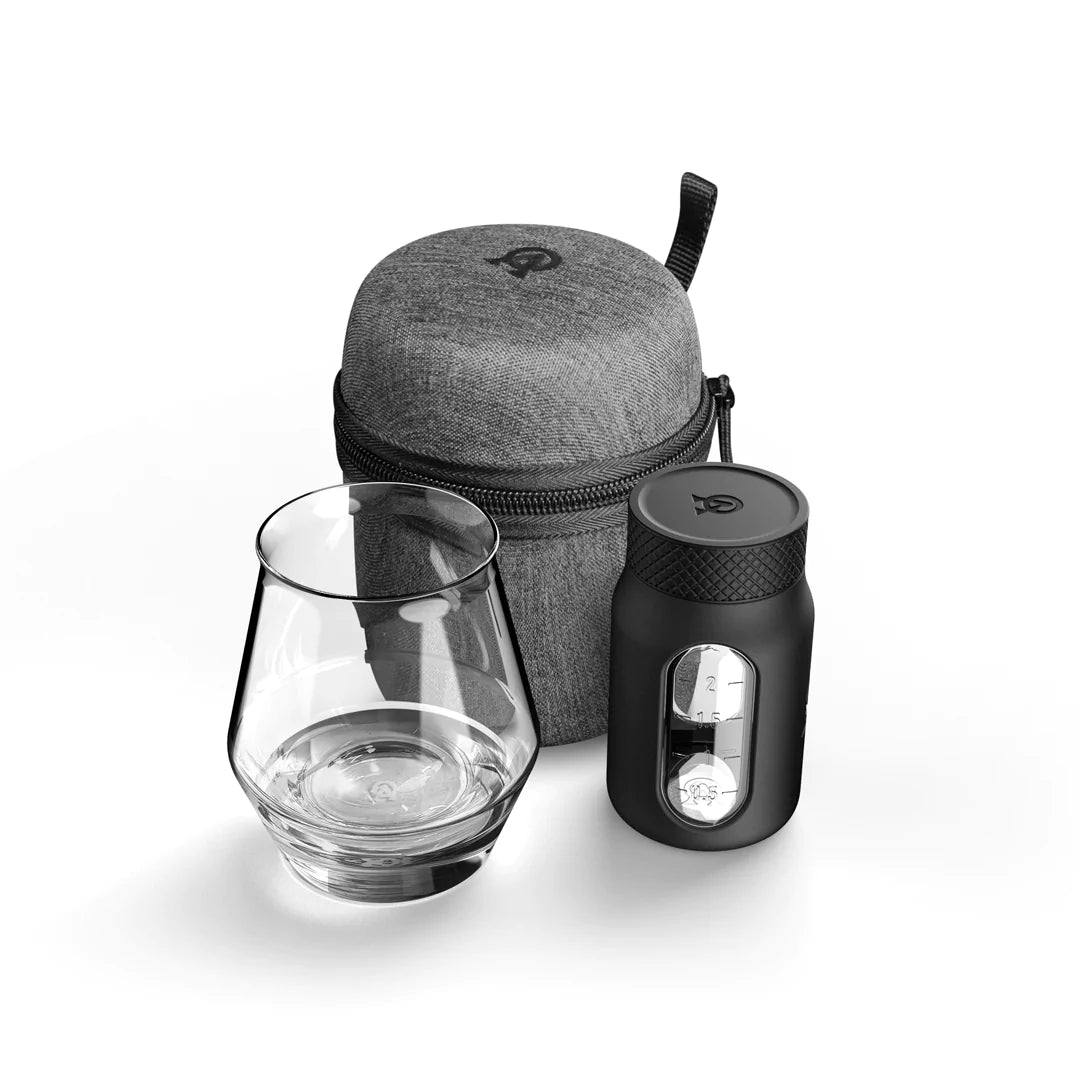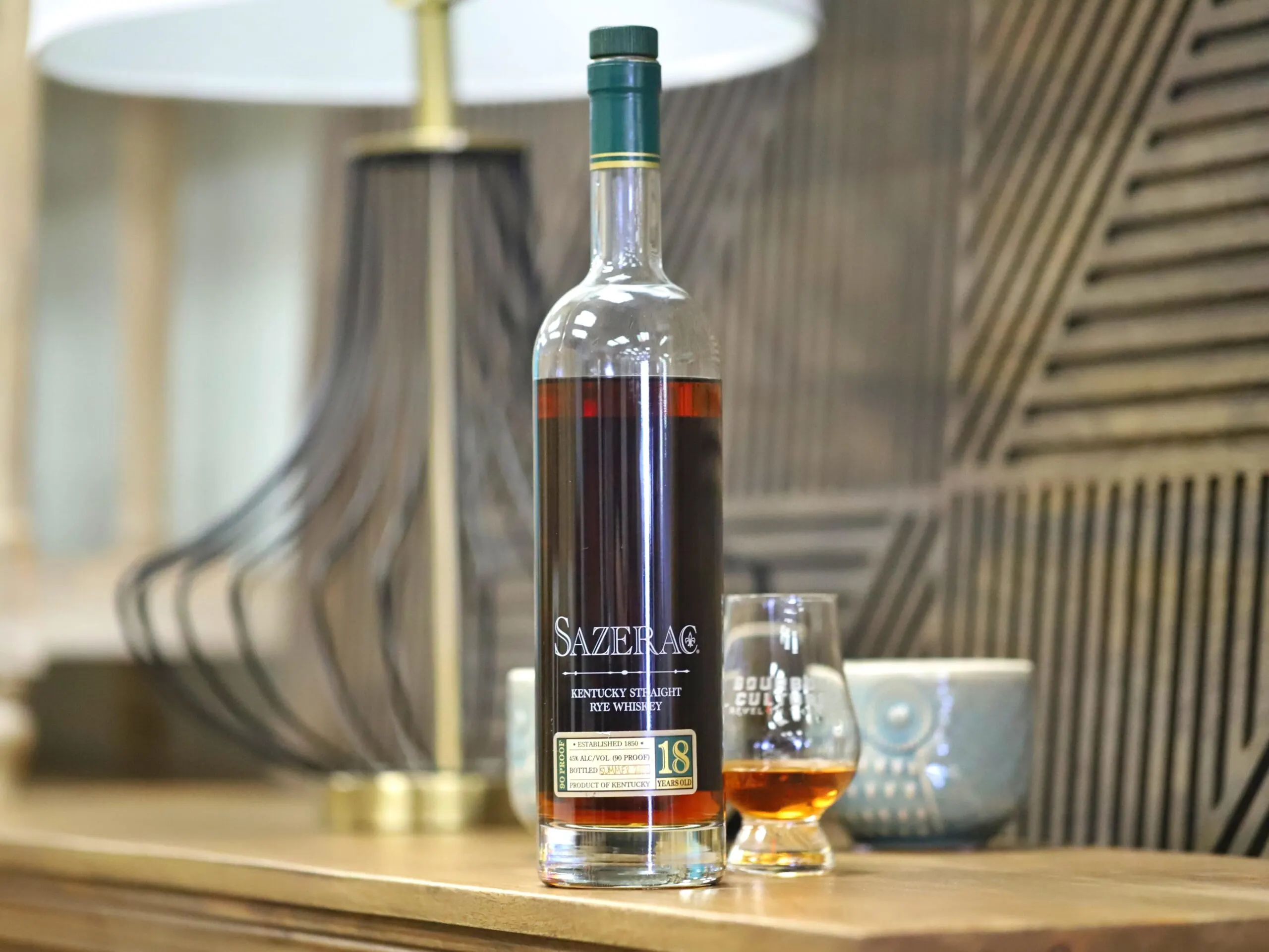| Don't like ads? | No ads |
Depending on your viewpoint, Sazerac 18 Year Old Rye Whiskey (also referred to as Saz18 by enthusiasts) is either the most desirable bottle in the Buffalo Trace Antique Collection (because of its age) or the least desirable bottle (because of its proof). This 18 year old rye whiskey’s age harkens back to a period of time where nobody was really buying rye whiskey and as a result, the barrels aged for longer than distilleries intended.
How it started vs How it’s going
In my previous reviews on Van Winkle Family Reserve Rye and Michter’s 10 Year Rye, I’ve tried to paint a picture how the late 90’s/early 00’s had 3 very mature stocks of Kentucky rye whiskies floating around (of note: I am not counting the Heaven Hill-distilled rye that would eventually become Rittenhouse 21/23/25). Medley-distilled rye whiskey stocks were exclusively bought up by Julian Van Winkle III. Cream of Kentucky rye whiskey stocks (which was distilled under Schenley’s supervision at the Old Bernheim Distillery) were most prolific – with most of it ending up at Kentucky Bourbon Distillers (KBD also known as Willett).

The third set of rye whiskey stocks was allegedly distilled at the Ancient Age Distillery (now called Buffalo Trace). I say “allegedly” because some enthusiasts disagree that AA ever made that rye whiskey. Those same enthusiasts speculate that it was actually older stocks of rye whiskey made at Old Bernheim.
These “Ancient Age” barrels are what I’m going to be looking at along with how it shaped the lore behind Sazerac 18.
Sazerac 18 Year Old Rye Whiskey – one of three original members of the Buffalo Trace Antique Collection
Many of us look at the modern day Buffalo Trace Antique Collection and automatically assume there’s always been the same core lineup of Sazerac 18, William Larue Weller, Eagle Rare 17, Thomas H. Handy and George T. Stagg. But the truth is that when Sazerac 18 was first released in 2000, George T. Stagg and Thomas H. Handy did not exist yet. The BTAC lineup only had 3 bottles in it (Fun Fact: all of them were bottled at 90 proof).
Two competing theories about the origins of Sazerac 18
As with most historical topics, the truth gets foggy when it wasn’t recorded into the public realm. What I mean by that is that the origins of all kinds of whiskey is usually cloaked in secrecy. That means that the history of where a particular kind was distilled or how much was made or what the mash bills were have been verbally passed down over the course of many years. And if you’ve ever played the game “telephone,” you’d know how quickly the stories can change.
That’s why I’m going to re-tell the two competing stories on the origins of Sazerac 18.
Theory #1 (Let’s call it the Julian Van Winkle storyline)
Julian Van Winkle III was a very active member on straightbourbon.com, the premier source of American Whiskey knowledge back in the day. In fact, if the internet was as widely available back in the early 2000’s, I’m sure he would’ve been issued many cease-and-desist letters from all the information he expanded upon. On second thought, he probably wouldn’t have been because a lot of the knowledge he was sharing was coming from distilleries and companies that were folding.

His version of the origins of Sazerac 18 came from the late-90s when he was searching for some stocks of rye whiskey to bottle for customers and under his own label. Rye whiskey from Medley, Cream of Kentucky (Old Bernheim) and Ancient Age were all on the table. He ultimately decided on the Medley rye whiskey and rejected the Ancient Age barrels.
He referred to the Ancient Age rye whiskey by that name because he said it was a batch of barrels distilled at the George T. Stagg Distillery (which was the Ancient Age Distillery later and is now the modern-day Buffalo Trace Distillery). His story was that the customer sold the unwanted barrels back to Elmer T. Lee.
These barrels would have been distilled in 1982. And according to some members on straightbourbon.com, they were probably destined for the Schenley-owned Cream of Kentucky brand. Schenley owned the George T. Stagg Distillery (as well as Old Bernheim) at that time and were producing whiskies on a rotational basis across multiple distilleries. Tracking down the exact distillery they were made at during that time is virtually impossible.
Julian outright says the barrels Elmer received back then became the tanked version of Sazerac 18 that they used for years. The amount they released every year was carefully regulated so that they wouldn’t run out before Buffalo Trace’s own rye whiskey came of age.
Theory #2 (Let’s call it the Steve Neese storyline)
I’m crediting Steve Neese with this theory because I heard it from him first. This timeline falls on the fact that Schenley made a batch of rye whiskey at least once a year for no dedicated purpose. But if the opportunity came up, they’d have stocks on hand to bottle or sell.
Schenley made their rye whiskey primarily at the Old Bernheim Distillery under the auspices of a future use within the Cream of Kentucky brand. It almost assuredly went unused year after year. Schenley was bought up by United Distillers in 1987 and the Old Bernheim plant went silent and was eventually torn down to build the New Bernheim plant in its spot. United Distillers merged with Grand Metropolitan in 1997 to become Diageo. Shortly afterwards they began to sell off brands, distilleries and stocks of barrels.

A lot of the rye whiskey destined for the Cream of Kentucky brand were bought up by Even Kulsveen at Kentucky Bourbon Distillers (modern-day Willett). But some of them were purchased by Sazerac/Age International.
It is theorized that a batch of rye whiskey barrels distilled in 1981 at the Old Bernheim Distillery had been batched together for the 2000 release of Sazerac 18. This was followed by a batch of rye whiskey barrels made in 1983 at the same distillery being used in the 2001 release of Sazerac 18. Then the batch of rye whiskey made in 1984 was batched, tanked and stretched out over the course of three years – from 2002 to 2004. Finally, the rye whiskey made in 1985 was vatted and used from 2005 to 2015 (note: some believe it was used from 2006 to 2016).
Sazerac 18 – from 2005 to 2016
There is another divergence of opinions on how the barrels that made up the batches during this period of time were stored. One theory is that they arrived sometime in 2005 and were immediately dumped into one single tank. This is derived from a question that was once posed to Mark Brown (Buffalo Trace Executive Chairman) about how many vatting tanks Buffalo Trace had on hand. Brown answered that he believed there were 2: One contained unspecified rye whiskey and the other was tanked Weller 12 that was becoming over-oaked.
The second theory is that the Ancient Age rye whiskey barrels were individually tanked and batched each year. Here are some of the finer points:
The multiple batches of tanked whiskey theory
It’s not unheard of for a distillery to dump valuable whiskey that is fully matured into individual stainless steel drums. Removing it from oak is the only way to ensure it won’t get over-oaked because it stops the aging process. The drums look like this:

When I toured Michter’s Distillery in Shively, one of the first rooms we walked into had stacks of stainless steel drums that contained their 10, 20 and 25 year old whiskey (note: not all of their 10+ year barrels, just some). With sealed lids, these whiskies can spend a very long time inside without much risk. One big benefit of storing them this way rather than a giant tank? They can be easily moved around and blended more precisely.
There are lots of charts floating around on the internet that show how many barrels were used per release of Saz18. If all of the whiskey was vatted immediately upon receipt, how could the numbers of barrels per batch exist? It seems extremely unlikely that anyone would have taken the time to come up with a formula for how much volume was used and how many barrels that equaled.
The theory is that they would select around 28 barrels each year and batch them together for the annual BTAC release.
The one giant tank theory
In 2004, Julian Van Winkle III has been quoted by saying that Buffalo Trace built him a giant tank to dump his Medley Rye Whiskey into. Shortly thereafter he dumped in stocks of Cream of Kentucky rye whiskey to stretch his blend. This meant that Buffalo Trace had experience with creating vats this large for storage purposes.
As the tank was slowly emptied, oxygen could have moved into the air space above the whiskey and oxidized it a bit. This could have been the culprit for the flavor differences between batches. Or, after seeing the hubbub that enthusiasts created between ECBP C923 with the laser codes A22 and A23, maybe the difference between batches is all in their heads.
Sazerac 18 – from 2016 to the present
It is widely assumed that Sazerac 18 was 100% Buffalo Trace-distilled rye whiskey starting in 2016 (some say 2017). To many enthusiasts, the change in profile was noticeable. What is interesting to me is that Buffalo Trace apparently kept the barrel count for each release just as low as they did in the past (and in many cases, sometimes lower). This trend continued up until 2019 when Buffalo Trace decided to not publish batch size or case counts for any more of their BTAC releases. It is assumed that the batch size has increased, but by how much is not known.
Sazerac 18 is widely assumed to utilize the same mash bill as Thomas H. Handy, Sazerac Rye, Buffalo Trace Kosher Straight Rye and Van Winkle Family Reserve Rye Whiskey. Of course, the difference is in the age, proof and barrel selection criteria of each.
The bottle I’m reviewing today is a 2020 release of Sazerac 18. This release’s actual age was 18 years and 4 months old and had around a 75% evaporation rate loss. So how does it taste? Let’s find out. I sampled this neat in a glencairn.
Tasting Notes
Nose: Initially, the sweet scent of candy corn wafts into my nostrils. Next come the fruit notes like cherry lozenges and lemon citrus. The baking spices are very light overall. Only after a little more time with the glass do I begin picking up on the scents that remind me of a rye whiskey like mint, various herbal notes, floral notes (including mums) and fennel seed. There is a light potpourri aroma that follows throughout. The age shows itself through antiqued wood notes. As a bit of a spoiler, I’m finding the nose to be the best part of the whole dram.
Palate: Each sip delivers flavors that showcase its age. Antiqued oak notes and spent cigar butts blanket the other flavors in their mystical tannins, but as the session goes on, those notes begin to take over the entire experience. Cherry sweetness and plays with red pepper flakes. Fennel seed and star anise interacts with cinnamon. And a hint of mint can be found mid-palate. For being only 90 proof, it sometimes feels a bit higher. I attribute it to the spicy kick (similar to red pepper flakes) that can be found throughout.
Finish: The finish begins to fall apart when the sip is complete. I’m getting a sort of stale tobacco note that pairs with other dry and tannic notes. Cinnamon, tree bark and a bit of baker’s chocolate are not notes you’d expect from a bottle with a secondary value in the the thousands. Old leather and allspice wrap up the experience. What happened?
Score: 7.3/10
My first sip of the 2020 release of Sazerac 18 was pretty good, but not mind blowing. “That’s okay,” I thought to myself “I’m just warming up my palate.” But each sip revealed no revelatory flavors that I had previously missed. Instead, the finish continued its assault on my tongue; drying it out to the point where it felt like I had been fitted with a pair of wooden dentures.

There were some very nice moments throughout. I enjoyed being able to taste some of the rye notes that I thought would have vanished with that much time in a barrel. The oak made it harder to find as the session went on, but there is a feeling I got with each sip that I could tell this was a Buffalo Trace product at its heart.
This is a whiskey that doesn’t deliver on the hype. So would I recommend paying the high sums of money a bottle like this goes for on the secondary? No. But if an 18 year old bottle of rye whiskey is what you really desire, I’d suggest finding a bottle of Redemption Rye 18 instead. That’s been the pinnacle of any rye whiskey bottled since at least 2017.
Final Thoughts
I paused before I started to write the conclusion to this review to reflect on my thoughts to this bottle. I was thinking how much differently I would have rated it if I had reviewed it a few years ago. I think I probably would have given it a much higher score based on the awe I had for BTAC releases. But as time goes on and I get to taste more of them, my admiration has leveled off for many of their releases.
That’s not to say that all BTAC releases are let-downs. I just think that expectations versus reality are important to keep in mind while drinking any BTAC (regardless of your experience level). I used to think that every year’s five bottles were a gift from the whiskey gods – but that’s just not the case.
It’s a little bit sad when you meet one of your heroes and they don’t turn out to be what you thought they’d be like. I feel this way with the 2020 release of Sazerac 18. It misses the mark of greatness I thought it had given its pedigree. I guess they can’t all be winners after all.
Featured Products
- Neat Traveler

- View Larger
- Description:The Aged & Ore Neat Traveler is a complete travel kit for spirits. We combined our widely praised Neat Glass with one of our 3oz Flight Bottles and housed them together in a custom EVA travel case. Perfect for a night away with your favorite pour. The tie
- Bottle Flight

- View Larger
- Description:The Aged & Ore Bottle Flight is a premium set of 4 custom silicone wrapped glass bottles designed to transport and share samples of your favorite spirits. The flight bottles come in a custom EVA travel case that fits perfectly in any small bag. An Aged &
- Travel Bundle

- View Larger
- Description:This Bundle combines two of our crowd favorite products, creating the ultimate travel bundle to bring along your favorite spirits and glassware. Bundle Includes: Neat Traveler (Gray) Bottle Flight (Gray) Note: This bundle is only available in gray and col
*Bourbon Culture is reader-supported. When you buy through links on our site, we may earn an affiliate commission.

